PINE TELES #1-10

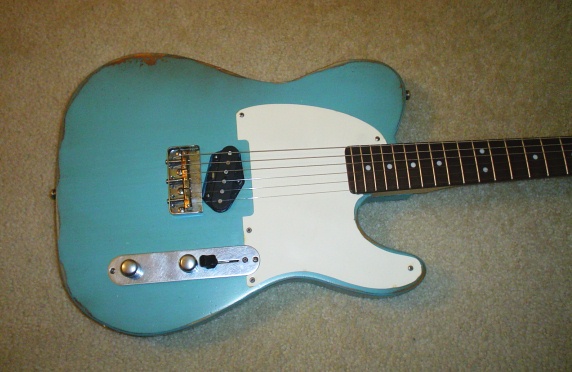
FENDER ''NOCASTER'' ESQUIRE
Fender pine guitar #1. My third overall pine guitar - behind my Charvel Telehawk and Jackson '49 Pinecaster guitars.
This one started when I saw a guy on eBay from St. Louis selling white pine Tele bodies already painted and worn in/relic'd. How cool is that? He had a few colors to choose from, but I picked a relic'd sonic blue (front back). The body is very light, and the pine slab is center-joined and no knots are visible through the thin nitrocellulose lacquer - nice quality. To keep things simple, I wanted to go with an Esquire setup - just a bridge pickup and I wanted an off-white (parchment) pickguard for a nice, clean look - similar in appearance to my light blue Fender Squire Precision Bass.
For the neck, I decided to go with a Mighty Mite rosewood Tele neck - one of the new ones they're doing in 2010. Previously, Mighty Mite Tele necks were 21 frets and the 12th-fret dots were kinda wide apart, but this year the manufacturer began making Tele necks with 22 frets and with the 12th-fret dots much closer together - 5/8", as on a Charvel or classic Fender guitars. (I have a 2010 Mighty Mite 21-fret, birdseye maple neck on my Fender Nashville Telecaster with the two 12th-fret dots closer together.) I thought the rosewood looks really good with this shade of blue, and this project is my take on a 1959 mod. I ran into an issue with the neck pocket on this body (not deep enough), so I had to lower the pocket with my Dremel and that was a bit of a challenge working with the soft pine. It turned out fine, but I wouldn't want to do that again. I had to build up the edges with some thick paper - oh well. The neck fits snug.
In terms of hardware, I always wanted to try a Tele "half bridge", as used on Fender's G.E. Smith Telecaster and luckily Wilkinson makes a great version of this bridge - complete with the same offset brass saddles as on its standard Tele bridge. To keep things in the vintage light, I went with vintage Wilkinson Deluxe split-post tuners (I had to use the conversion bushings for the 10mm tuner holes) and those are fun to use. A little winding, but no big deal. Of course, Schaller straplocks. I also ordered a vintage chrome Fender neck plate, and like all the hardware on this guitar, I roughed it up to give it the "relic'd" look. And I only use Electrosocket jack cups on my Teles.
I went all out for the electronics. Even though I enjoy using the soldering gun and wiring these single-pickup guitars myself, I went on eBay and purchased a custom pre-wired harness. This harness features top-of-the-line components, such as a Switchcraft jack, Russian K40Y "Paper In Oil" capacitors (.047 uf [2], .001 uf @ 200V), two CTS 250K pots, and a genuine 4-way Fender switch - yes, a 4-way switch. How does a single-pickup Esquire have a 4-way switch? Well, just like my one-pickup Fender Esquire has a 3-way switch to achieve different tones, this custom harness allows me to to get a "Cocked Wah" in positions 1 (low filter) and 2 (high filter), and standard settings in 3 (with tone knob) and 4 (tone bypass). Very cool indeed. And of course, with such a sophisticated setup, I needed to get a really cool Tele bridge pickup, and I did by picking up an Illusion 1959 Esquire Reproduction with raised D and G poles - the perfect year! All around a fantastic set of electronic components and a breeze to hook up. Not sure I have another guitar with better electronics.
I went with a simple Fender waterslide on the headstock, in honor of the old "Nocasters". Technically, this guitar isn't based on any past model Fender made. The actual "Nocasters" that Fender made in 1951 were actually two-pickup guitars. The Broadcaster (two pickups) and the Esquire (one bridge pickup) models both came out in 1950 (before the Broadcaster name was put in use, the first two-pickup models were called Esquires, too). But in early 1951, Gretsch asked Fender to stop using the Broadcaster name because it had a drum kit with the similar Broadkaster designation. So Fender complied, but still manufactuered its two-pickup model for several months, but with no model name under the Fender decal on the headstock. Later in 1951, Fender came up with the hip Telecaster name (named after the new television era sweeping across America in the early '50s) for the two-pickup model. But these "no-name" models produced by Fender in the interim are known by collectors as "Nocasters". So the Broadcaster, "Nocaster", and Telecaster models are essentially the same two-pickup guitar. Any one-pickup guitar manufactured during this time would have had an Esquire decal on it.
Also in 1951, Fender had already ditched the pine bodies for ash, so there were never any pine, one-pickup "Nocasters". And although Fender did not begin using blue finishes (Daphne, Sonic, Lake Placid) as part of its standard/published "custom options" until 1961 (cost 5% more), it was possible for high-profile players to get similar paint jobs in the 1950s for an extra cost. Another main difference is my custom, 4-way switch, "Cocked Wah" wiring job. The one-pickup Esquires had one volume, one tone, and still had a tone-shaping, 3-way switch (just like my Fender Esquire). Rosewood fretboards didn't begin appearing on Teles until 1959 - what a coincidence, although 22-fret necks weren't used until 1984. Whew! Enough disclaimers.
Not much more to say except I love the way this thing looks - the color of the blue with the rosewood fretboard and the worn chrome hardware. I absolutely love the lightness and tone of the pine body and the feel of the Mighty Mite neck. And I'm sure I do not have a better-sounding guitar when strumming it on the couch unplugged! Must be the fact that the pickup is screwed right into the pine body. And the "Cocked Wah" electronics sound very cool. Can you tell I love this guitar? An amazing pine project, indeed.
November 2010
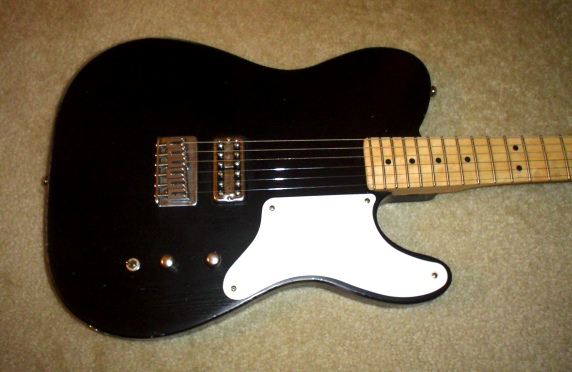
FENDER ''LA CABRONITA ESPECIAL'' CUSTOM
Fender pine guitar #2, and oh my gosh - this guitar is a little bitch! (That's what "La Cabronita" means in Spanish and the name actually fits!)
I had seen TV Jones pickups around for years, but because they really aren't made to fit standard humbucker routes and they are meant to mimic classic tones (see - Gretsch Filtertron), I had always passed. And they're not too cheap, either. And I had seen Fender's "La Cabronita Especial" guitar in a few places, but didn't quite understand and appreciate it. Then I saw a guitar body manufacturer on eBay making the "La Cabronita" body in pine, and during my "pine body craze" in 2010, I did some research and had to have one. But the real Fender "La Cabronita Especial" is made from relic'd alder and is thousands of dollars (only 40 total were made by Fender's Custom Shop - one in each color [black, red, white, gold]). For the initial release, Fender made two versions of the axe - a two-pickup and one-pickup Especial; and when I saw the one-pickup "La Cabronita Especial" in black, I knew I had another project coming my way.
After seeing the Fender "La Cabronita" and the Red Dirt Guitar Works "La Cabronita" pine Tele bodies, I knew this would make a fun project. I ordered a single-pickup, two-piece, center-joined pine "La Cabronita" body (with just a couple of small knots) and proceeded to paint primer gray and then black. The body is absolutely amazing. I love the fact that it's rear-loaded - looks killer! I had to drill three control holes through the top of the body for the volume, tone, and on/off switch, but more on that later. For the neck, I went with a Mighty Mite, 22-fret, maple neck and added a black and silver 70s Fender waterslide. And, of course, I relic'd the heck out of both the body and neck.
For the hardware, I was lucky in that Warmoth makes "La Cabronita" pickguards, so I ordered a white one and aged it up a bit. I also tracked down a chrome, undrilled Tele control plate, to use as the rear control cavity cover. The authentic "La Cabronita" utilizes a chrome Fender hardtail bridge, with modern 52.5 mm stainless steel saddles, so I picked up one of those off eBay. I also used the standard (for my pine Teles!) nickel string ferrules, chrome Schaller straplocks, mini chrome Carvin knobs, and an aluminum Electrosocket jack cup, as well as a genuine Fender neck plate in chrome. For the tuners, I went with chrome Schaller (locking) and I added the mini pearloid tuner buttons, so it would resemble the original. I dented, scratched, burned, and dinged all the hardware to fit into the "relic" theme.
When it came time for the electronics, I knew I had to get a TV Jones pickup, as that is what the pine body was routed for. The real Fender "La Cabronita" (single pickup model) is outfitted with a Power'Tron model, but I decided to go with the TV Classic Plus model, thinking it would sound a little more vintage. I ran into an issue when I intended to "relic" the pickup, and I had to send it to Smit's Pickups for a quick repair (I damaged the windings on one of the coils). Thanks for your work, Kevin! Now the pickup just looks like it was run over by a truck, and it sounds amazing! For the rest of the electronics, I used Carvin mini 500K pots (volume, tone), a mini on/off switch, a .022 uf Sprague Orange Drop tone capacitor, a ceramic .001 uf volume roll-off capacitor, and a Switchcraft mono jack. And yes, I wired it all up myself.
I set the action up great and this axe sounds vintage raw. Perfect for old AC/DC. This pine body actually has a little weight, too. It looks just like the official Fender "La Cabronita" axe, but it's about $2500 cheaper! Some of the difference between my take on the "La Cabronita" and the official Fender "La Cabronita Especial" specs are as follows:
--22-fret neck vs. 21-fret neck
--compound fretboard radius vs. 9.5"
--synthetic bone nut vs. real bone
--1 5/8" width at nut vs. 1 11/16"
--70s-style Fender logo vs. 50s spaghetti
--two-piece, center-joined pine body vs. alder
--on/off switch vs. "Greasebucket" tone circuit
--chrome mini knobs vs. standard size
--chrome control plate back cover vs. white cover
--TV Jones TV Classic Plus humbucker vs. TV Jones Power'Tron
--Schaller locking tuners vs. Sperzel
--no "La Cabronita Especial" decal on body back
April 2011
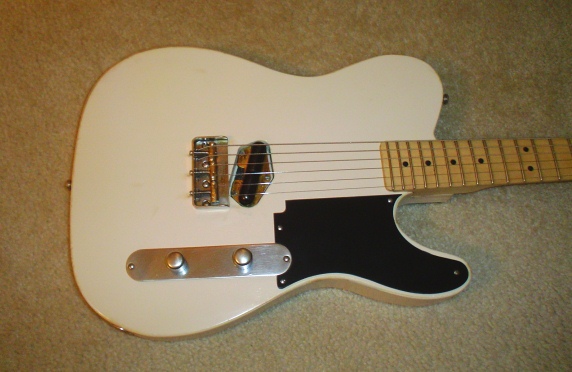
FENDER BROADCASTER JR
Fender pine guitar #3! And I finished this one before I finished #2 (Fender ''La Cabronita Especial'' Custom).
I got the idea for this pine relic job while browsing online through some photos of custom Telecaster mods - like this one with a P-90 pickup. I want to do a Tele with a P-90 at some point, but when I saw the pine one-pickup, Esquire-style body on eBay for such a low price, I thought I could make something cool. Not long after, I read how there were a couple of "Tele-like" prototypes (l to r, white Snakehead prototype #1, natural prototype #2, black Broadcaster) made by Fender in the summer/fall of 1949 before the Broadcaster appeared in late 1950. And then I stumbled on this pic of a vintage-looking Tele, which is apparently someone's version of an "in-between prototype" of the Snakehead and the Broadcaster, with a Tele bass conrol plate. I'm not sure how many prototypes were made between the Snakehead and the first Broadcaster, but I'm always reading and looking online for more clues.
When it came time to paint the two-piece (offset), Red Dirt Guitar Works pine body, I decided to first go with white primer and then I gave it a thin coat of bright yellow. The main color is Rust-Oleum's "Ivory Silk" and it's a satin finish. I then thoroughly wet-sanded the entire body and the layers of color came out in a really cool blend. And then I went to work giving it nicks, cuts, dings, and dents in various places to make it appear as a road-worn instrument from decades ago. So I had the body - now for the neck. I went for another Mighty Mite maple Tele neck - with a V-contour back - like the one on my Jackson '49 Pinecaster. These new Mighty Mite Tele necks in 2010 are great! I roughed it up a bit and applied a custom Fender Broadcaster Jr waterslide on the headstock. I added nickel vintage Wilkinson Deluxe split-post tuners and I was in business.
For the bridge, I went with same Wilkinson bridge I used on my Fender ''Nocaster'' Esquire - the chrome Tele "half bridge". I also went with a set of really cool Hipshot Compensator brass saddles, as they have the slotted height-adjustment screws (more on the importance of slotted screws later). For the pickguard, I got a stock black Esquire pickguard and cut it to look like the one with the P-90 pickup. Of course, I roughed up all the hardware a bit to give it a nice "relic'd" look. I also scratched up and dinged the body hardware - the Fender neck plate, the custom control plate, the two knobs, and the Wilkinson "half bridge". It really is a "custom" control plate, as I ended up buying a full plate online and drilling the two holes (volume & tone) myself - no switch on this baby.
There are two areas on this guitar where I really wanted to go vintage - the screws and the electronics. It's a well-known fact that the earliest Fender senior solid bodies used slotted screws from inception until 1954. Luckily, there are shops online that sell Tele slotted screw packs and I was able to replace every Phillips-head screw on the guitar with vintage slotted screws. How cool is that? Every screw is slotted - from the neck plate, to the Schaller strap buttons, to the tuner mounts, to the Electrosocket cup, to the round string tree, to the intonation and height adjustments on the Hipshot saddles. As far as the electronics, I wired up everything myself, using 250K CTS pots, a Switchcraft jack, and an amazing Paper in Oil REPRO Cornell-Dubilier ZSW 1S5 .05 tone capacitor. I also added a ceramic .001 capacitor on the volume. Very cool indeed!
And then there's the pickup. I wanted something unique - not another typical Tele bridge pickup. So I went with the GFS Pro-Tube Lipstick Tele bridge in black. Nice and noisy and reckless. Not your Dad's Tele bridge pickup! As with my Fender ''Nocaster'' Esquire with the Wilkinson "half bridge", the pickup is screwed directly into the wood body, which I'm sure aids in the tone. I have a set of GFS Pro-Tube Strat Lipsticks in my Fender Lipsticaster, and those ProTubes sound amazing and unique, as well. I continue to be impressed with GFS pickups' quality - there's no better value in pickups out there.
This guitar is strongly related to my Fender ''Nocaster'' Esquire, in that they both have the Wilkinson "half bridge", nickel Wilkinson Deluxe vintage tuners, and a single bridge pickup. But there are enough differences - maple vs. rosewood necks and the body color... I just love the cream-like color on the this body. And this pine body is much heavier than the one on my Fender ''Nocaster'' Esquire. Another great pine Tele project (this one represents a 1950 mod) - everything fits well, sounds good, and feels great. And the relic'd look is a lot of fun to apply!
December 2010
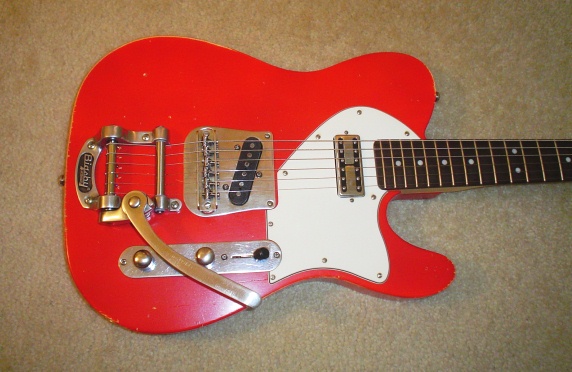
FENDER TELECASTER -Bigsby-
Fender pine guitar #4! I've always loved the look of a Bigsby vibrato on a Telecaster, and there's something about Fender's fiesta red color with a white pickguard. And add a Bigsby and rosewood neck to those colors? Perfect! So this pine project inevitable.
I actually picked up this Red Dirt Guitar Works pine body used off of eBay - it's a two-piece, center-joined slab with a neck humbucker route that the original owner sprayed the classic butterscotch blonde (more yellow, really). I sanded it down a bit and sprayed it with white primer and then a light satin yellow. For the fiesta red color, I went with ReRanch's special spray can - not a cheap spray paint can you buy at Home Depot! It turned out pretty good, although it's more translucent than I thought. Fender first offered this "custom" color in 1961. I then "aged" the body quite a bit and I didn't add any clearcoat. And even though this body has a top-loading Bigsby, I added the nickel string ferrules on the back. I guess this model is based on an early-1960s Tele that was modified before Fender officially began offering the Bigsby option in 1967 (Fender Bigsby Teles featured an 'F' on the vibrato plate - not the Bigsby logo).
The maple/rosewood neck is the same kind of neck I've used on all my Fender Pine Tele projects - the new 22-fret Mighty Mite neck. Great quality and value. I lightly aged the fretboard and gave the headstock a nice relic'ing after I added a vintage Fender Telecaster waterslide in a late-1950s/early-1960s pattern/location. I went with nickel Fender/Gotoh vintage split-post tuners - they work great and look amazing after some light aging.
For the pickups, I went with GFS again - a Liverpool Minitron Vintage mini-humbucker in the neck position and a 63 Overwound Professional Series in the bridge. I lightly relic'd each pickup and they balance out really nice. The 63 bridge has a nice hot, crisp edge, while the neck humbucker is a cross between a smooth '59 and a mellow TV Jones Classic. The two together (middle position on the 3-way switch) sound really, really good. For the rest of the electronics, I went with a 500K volume pot, a 250K tone pot, and a Fender 3-way switch. I added a .047 uf Sprague Orange Drop tone capacitor and ceramic .01 cap for the volume. I wired everything up myself to a Switchcraft jack housed in an Electrosocket cup. I got both pots from GFS (split post) and I tracked down some nice-looking, chrome push-on knobs. I then aged the knobs and the chrome control plate.
As stated earlier, I went with a Bigsby vibrato. I picked up a WD Bigsby Telecaster kit on eBay for around $100, which contained an aluminum B50 Bigsby, a chrome Tele bridge pickup plate, a chrome WD Mustang-style Tune-O-Matic, and all the necessary screws. it wasn't that hard to install and everything lines up perfectly. And yes, I lightly aged the entire bridge/vibrato assembly. Other hardware used on this project are a chrome Fender neckplate, a standard string retainer, Phillips-head screws, and a parchment-colored, Warmoth 'hybrid' pickguard. Warmoth's hybrid Tele pickguards are have a unique cut and are modeled after the pickguards on the Thinline Telecaster models (debuted in 1968) that required a modified guard due to the F-hole on the body face. I thought this pickguard looks really unique with the Bigsby setup and Warmoth makes it easy to order pickguards with a lot of pickup route choices.
What more can I say about these pine bodies? They look great, smell great, are easy to work with (route, chisel, drill, sand, paint, etc.), are lightweight, resonate well, and make the guitar's natural tone sound amazing. I'm really getting into the whole "Fender Telecaster history" and I find it's really addicting. While I didn't model this particular Tele after one specific year, I do think it closely follows, say, a 1962 Tele where the owner added a Bigsby, a new neck pickup, and a custom pickguard. The GFS pickups sound great (as always), and everything is set up well. Another successful pine project. Moving on to the next one!
March 2011
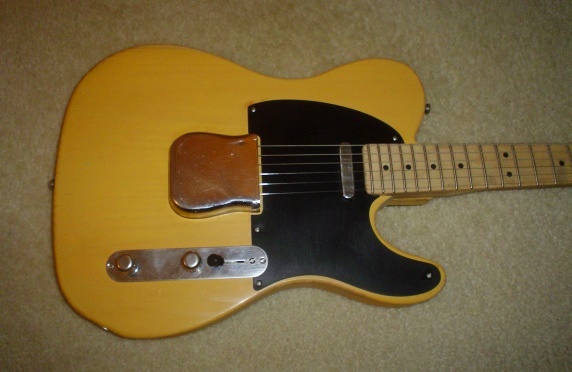
FENDER BROADCASTER
Fender pine guitar #5!
How could I possibly get going with a bunch of pine Tele projects, and not make a Broadcaster? I got off to a rough start with this project, as the Red Dirt Guitar Works pine body I ordered (standard route with channel between neck pickup and control cavity) got lost in shipping. Thankfully, the folks at Red Dirt in Decatur, TX, were more than cool and replaced it with a perfect pine Tele body - two-piece, center-joined, zero knots - everything is perfect. At least until I painted it and relic'd it - my favorite part! The paint job (technically "stain" job) was actually something new for me, as I went with ReRanch butterscotch blonde spray. It's a nice, translucent color that gives the pine a beautiful, aged yellow look. I put on about three coats, and it probably is a little dark, so if I ever do another one, I'd most likely stop at two. No big deal. I then sprayed it with ReRanch satin clear, and that really sealed the color and added a nice uniform lack of gloss, if that makes sense. For the neck, I went with the standard Mighty Mite maple Tele neck with 22 frets, and applied a vintage-looking Fender Broadcaster waterslide to the headstock, before hitting it with my aging process to it.
To keep with the vintage theme, I ordered a pre-wired Broadcaster harness off eBay (onlymusic) that is wired up like the original 1950 axe. Even though the controls look like the typical "volume, tone, 3-way switch (neck pickup, both, bridge pickup)", they are not set up in that way at all. The first position on the 3-way switch is the neck is the neck position only set to a deep "bass" tone, and the "tone" control is inactive. The middle position on the 3-way is the neck pickup only sounding natural (no cap filter effect), and the "tone" control here is also inactive. The third position on the 3-way enables both the neck and bridge pickups on and the "tone" control here acts as a pickup blender for the two. The volume control is just that in all three positions. Crazy, huh? It's actually very similar to my Fender Esquire wiring. Anyway, the harness utilizes CTS 250K pots, a CRL 3-way switch, and a Switchcraft mono jack. The unique wiring relies on the .05 mfd 150v DC Vintage Repro capacitor and a 15 K Allen Bradley carbon composite resistor. And yes, it's worth it to have a pro wire this one up! When it came time to select some pickups, I had no choice but to go with a set of Seymour Duncans - the Vintage Broadcaster (STL-1b) for the bridge, and the matching Tele Vintage Rhythm (STR-1) for the neck. I lightly aged the pickups and wired these two up to the harness and they sound wonderful. Full-on vintage and there's some kick there, too.
I had a lot of fun acquiring all the vintage hardware for this one, and a lot of it was authentic Fender parts. I went with vintage Fender Tele dome knobs, a Fender neck plate, a Fender control plate, a Fender three-saddle (straight brass) ashtray bridge, Fender ash try cover, Fender/Gotoh vintage split-post tuners, Fender slotted screws (neck plate, tuners, pickguard, bridge, string tree, strap buttons [locks], control plate, pickup mounting), and a Fender vintage 3-way switch tip. Wow! And everything was chrome (except the stainless steel slotted screws, the nickel tuners, and the black plastic switch tip) and I aged everything. I also used the standard nickel string ferrules (5/16"), chrome Schaller straplocks, a nickel vintage string tree (circle), and an aluminum Electrosocket jack cup. For the pickguard, I ordered a Callaham standard, 5-screw Tele guard in parchment and aged to perfection. Note: I realize that it would have been historically accurate to use a black pickguard with the butterscotch blonde body color, but I really like the look of the vintage white/parchment pickguard with the butterscotch blonde, too, and I already have a Tele with that classic look (my Fender Esquire again). Besides, in my own "tradition" of laughing in tradition's face, I tend to go for unique modifications. Anyway, everything installed perfectly - no issues whatsoever.
1950 Broadcaster
1950 Broadcaster headstock
For historical purposes, it's important to note that demand dictated that Fender produce a two-pickup, solidbody guitar after the success of the one-pickup model, Esquire, in 1950. Before coming up with the Broadcaster name later in 1950, the earliest two-pickup "Teles" were also designated as Esquires. By this time, the pine wood used by Fender for the '49 prototype "Snakehead" and the early 1950 Esquires had been replaced by heavier, more durable ash, so there were never any pine Broadcasters in all likelihood. The Broadcaster model name only lasted for a few months - until early 1951 - when the Gretsch company objected to the name (it had a drum set named the Broadkaster). Fender complied with the Gretsch request (without any legal action needed) by changing the name of the two-pickup model to the Telecaster. (The two-pickup models manufactured in early 1951 after the Broadcaster name was dropped and before the Telecaster name was adopted are referred to as "Nocasters".)
As with my Fender Broadcaster Jr prject, I wanted to go with vintage-looking hardware and that meant going with all slotted screws. I purchased a set of vintage slotted stainless steel Tele screws from Callaham Guitars (through Specialty Guitars) and these worked well. Literally every screw on this guitar is slotted - just as they would have been in 1950 on the Broadcaster. As mentioned earlier, the vintage-looking parchment pickguard is also a Callaham product. And white (parchment) pickguards didn't appear on the Telecaster until 1954.
The project went very smooth (except for the shipping delay with the body), and this tribute to the 1950 Fender Broadcaster looks and plays great. And you can never go wrong with Seymour Duncan pickups. The vintage-authentic harness wouldn't be my first choice for a Tele-style guitar, as I'm really used to the modern wiring scheme, but it's something different and I'm all about that. This is also my first guitar (Telecaster) where I went out of my way to use the bridge "ashtray" cover, and I leave it on there (but it still looks good without it). I can see why a lot of players ditched/lost this part, and it actually would make for an innovative ashtray, if I smoked.
May 2011
UPDATE: April 2013
After a couple of years with the off-white "parchment" pickguard, I broke down and picked up a Fender matte black 5-hole Tele guard so it doesn't look like this anymore. Not a big deal to change, but it sure makes it look different. Anyway, I'll use that Callaham pickguard on another Telecaster project.
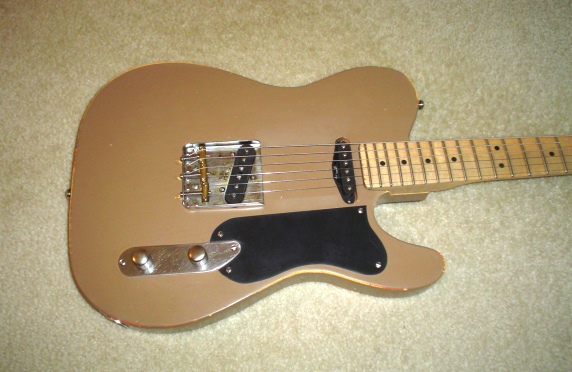
FENDER TELECASTER -Dirty Harry-
Fender pine guitar #6! First off, while I am a big fan of the 1971 Clint Eastwood movie, Dirty Harry, this guitar is actually named for the amazing Rio Grande pickups I used (which are named after Eastwood's character, so...).
And while I am a big fan of stock-sounding Tele pickups, there are more than a few manufacturers who offer some interesting variations. Sure, you can can get some great deals on some great-sounding pickups, but you can never go wrong with the hot boutique jobs. I've had a little experience with Rio Grande pickups before (Barbeque Bucker model) with my Fernandes Monterey Special guitar, and that axe sounds hot. The "Dirty Harry" Rio Grande pickups are modeled after the P-90, as the pole pieces on these pickups are slotted screws, so the poles can be raised or lowered easily - depending on your string height. And after reading all I could about the "Dirty Harry" set, I knew I had to have a Tele with these under the hood. And how could I not drool after reading the official Rio Grande description:
"Rio Grande is at it again! Like its namesake, the Dirty Harry for Tele emulates the tonal characteristics of a P-90 pickup, but made for a Telecaster. Don't use Tele bridge pickups that are a dead pool of anemic tone! Let the Dirty Harry unleash the magnum force of your Tele-style guitar and give your licks sudden impact on the audience! If you're a Telecaster player and you've never experienced P90 tone, you GOTS to know ... and now you can! Become an enforcer of Telecaster tone with the NEW Dirty Harry!" But more on the pickups later…
I got the idea for this pine Tele project while looking online at some killer Tele creations, in terms of color, pickups, pickguard, custom control plate, etc. - especially this unique brownburst Bigsby Tele. I really like the look of Fender's desert tan (or desert sand), as they used on the classic Duo-Sonic model, and I thought that it would look good with a "vintage-cut", black pickguard. I did some research on the desert tan color, and while the ReRanch site (I used their fiesta red and butterscotch blonde colors for my Fender Telecaster -Bigsby- and Fender Broadcaster projects) offers this color in a convenient spray can, I decided to just go with Rust-Oleum's Satin Nutmeg from Home Depot, although it's darker. Always looking for a deal!
For the wood, I ordered an inexpensive, three-piece Red Dirt Guitar Works pine body, with a standard Tele route. I decided early on that I wanted to do something that looked like a prototype Tele with the smaller Tele control plate (two pot holes – no switch), as found on the Tele bass, so I glued in a small pine dowel for the control cavity to make it smaller and so the top control plate screw could catch wood. I then primed the body with a flat yellow and then an orange (not sure why) and then sprayed it with the Satin Nutmeg, i.e., dark desert tan. If I had to do it all over again, I would have used either gold, black, or dark brown as color #2, but the orange tint gives a unique patina to the worn body edges, as well as the chips, dents, dings, and scratches. For the neck, I went with standard maple Mighty Mite and "relic’d" the heck out of it. I added a vintage black/silver Fender Telecaster waterslide and I used coffee, lemon oil, sand paper, steel wool, matches, etc., to damage everything. And it really looks good!
For the hardware, I went with a vintage Fender Tele bridge with the early 1950s, non-grooved brass saddles. I added Fender/Gotoh vintage tuners with split posts, Schaller straplocks, push-on knobs, a vintage Fender neckplate, an Electrosocket jack cup, and other standard, vintage Tele hardware in chrome/nickel. And of course everything was made to look really old! And I hand-cut the black pickguard – it's loosely resembles a cross between the pickguard on the unique brownburst Bigsby Tele and a "Hybrid" pickguard.
And then came the electronics. In addition to the amazing-sounding Rio Grande "Dirty Harry" pickups, I decided to go with a volume and blend pot set up, since there's no place for a switch on the small Tele bass control plate. I used a split-shaft 250K pot for the volume, and 500K split-shaft pot for the blender – the center detent is for both on and then it can be turned to get varying percentages from each pickup. I have other axes with a blend pot and I like this feature a lot. I didn't use any capacitors in the wiring and the output jack is a Switchcraft. And yes, I did all the wiring myself. One note – I had to chisel the neck pickup cavity a bit deeper, as the Rio Grande "Dirty Harry" RW neck pickup has a pretty deep magnet on it.
This project was meant to mimic a 1949 prototype of sorts (although Fender didn't switch to the Telecaster model name until 1951), as it has some of the "Snakehead-like" appointments (custom pickguard, small control plate). And all the screws are slotted! I really like the brownish color with the black pickguard and pickups, and the neck really looks good and old. And these Rio Grande "Dirty Harry" pickups are fantastic. Well balanced and they are definitely a cross between the standard Tele tone and a P-90 set. And the blend pot allows me to dial in some great tones. Another awesome pine Tele!
April 2011
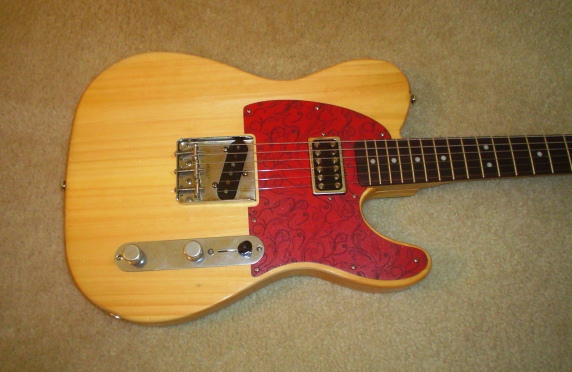
FENDER TELECASTER -Western-
Fender pine guitar #7!
For one of my Tele pine projects, I wanted to do a "natural" Tele and after seeing a couple of old west, cowboy-looking Teles, I got an idea. I wasn't going to go as far as getting a real leather pickguard, but maybe something that looked close. And I really liked the look of Fender's 2011 "Lamboo" Telecaster, which has a body made of laminated bamboo!
What I knew for sure is that I wanted a really nice pine body from Red Dirt Guitar Works - minus the knots and cracks on this one, since it would truly be a transparent finish. I ended up getting a perfect two-piece, center-joined body that was immaculate. The one catch was that I wanted to go with a neck humbucker, and the body I chose was routed for the standard Tele setup, so I had to get out the Dremel router and take some wood out of the neck pickup cavity. I then applied a couple of coats of tung oil and then sprayed it clear (before aging it). The oil really brought out the nice grain in the pine - especially the sides. For the neck, I went with the standard Mighty Mite Tele neck with a rosewood fretboard. I was a little surprised that it arrived with just 21 frets (all of my other pine Tele projects have 22-fret Mighty Mite Tele necks), so it's similar to the neck on my Fender Nashville Telecaster. Thankfully, it has the narrow-spaced, Charvel-style, 12th-fret dots, so I was cool with it. I applied a gold & black 1966-67 Fender Telecaster waterslide (more on that later) to the headstock. Here come the electronics.
I was very interested in trying out both the GFS Hot 1960s Alnico bridge Tele pickup, and the cool-looking Bigmouth Vintage humbucker (neck position) and neither was a disappointment. Instead of just wiring it up standard myself, I went online and purchased a pre-wired "Greasebucket", 4-way switch harness off eBay (onlymusic). It utilizes two CTS 250K pots, a Fender 4-way switch, a .1 ceramic cap, a .02 ceramic cap, and a 4.7K resistor. The 4-way switch enables me to get the two pickups on together in both series and parallel. Note that the official Fender "La Cabronita Especial" comes stock with the "Greasebucket" tone circuit. Fender describes the "Greasebucket" (a Fender trademarked name) circuit with the following:
"The Greasebucket tone circuit adds a new dimension to your tone, the effect is that when rolled down, the tone pot reduces the high frequencies, but does not add bass."
For the hardware, I went with a 1960s Tele bridge (the Fender name is stamped straight across the middle - not at an angle like the 1950s bridges) with steel threaded saddles (used from the late 1950s to the mid-1960s). For the pickguard, I tracked down a guy on eBay who makes real bakelite guards with a paisley design that resembles tooled leather in a way. I had him make me a reddish one cut for a neck humbucker and it's absolutely amazing - really makes this guitar. The paisley design is laser-etched and comes through as black - really cool! For the tuners, I decided to break from the standard Fender/Gotoh split posts and go with a set of GFS locking tuners. I also used Fender flat top knobs, an aluminum Electrosocket jack cup, Schaller straplocks, and a Fender 1970s "F" neck plate. Of course, I relic'd all the hardware so it looks like it's about 40 years old. That's the fun part!
I ended up doing a first for this guitar project - I branded an image on the body! I thought it would go with the "western theme" of the guitar - to brand an Old West image on the back of the body. I picked up a hefty steak brand off of eBay in the shape of a cowboy riding a bucking bronco and fired it up in the grill for about 20 minutes and pressed it into the back of the pine body - that was interesting! It sizzled and smoked and I only left it on there for a few seconds because it was going to burn right through the entire width of the body (maybe it was too hot?). Anyway, I still think it looks pretty cool. My daughter noted that the bucking bronco design is the same as on the 2007 Wyoming quarter, so I tracked one down and screwed it into the bridge pickup cavity before final assembly.
This guitar kicks ass. The GFS pickups are amazing for the tone they put out - what a value. The pre-wired harness adds some cool tone options, and the whole thing is set up killer. And then there's the look - country/western, but not too overboard - no leather on this baby! As far as the time period I was shooting for, this is meant to represent a 1966 Telecaster by the bridge and non-"spaghetti" script headstock waterslide. The Fender decal is mostly gold - in 1968 they went to mostly black with the "modern logo". The 1966-67 logo is often referred to as the "transition logo" - appearing for roughly two years between the "spaghetti" and black "modern" logos.
July 2011
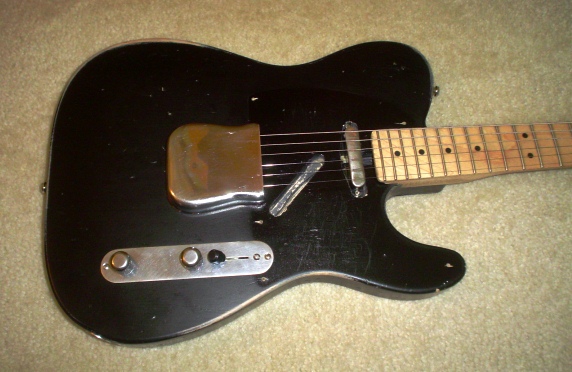
FENDER '51 ''NOCASTER'' -No Guard-
Fender pine guitar #8!
Despite the fancy name (Fender '51 "Nocaster" - no guard-), this is actually one of the closest guitars I have that resembles the famous standard Telecaster. While researching potential pine-bodied Telecaster projects, I came across a cool-looking Tele that had the channel route between the neck pickup cavity and the control cavity exposed - i.e., no pickguard, and I thought that it looked really bad ass! I was also intrigued with the mysterious black 1950 Fender Esquire (see below), and was looking for something similar to that. But first, a little history.
The first Fender electrics (called "Spanish" guitars back then) - both the one- and eventual two-pickup models - were actually named Esquire, and in early 1950, Fender issued a catalog that pictured a black one-pickup Esquire with a white pickguard. This was highly unusual, as Fender electrics at this time were all blonde (butterscotch) with black guards. Regardless, in late 1950, Fender renamed the two-pickup version the Broadcaster, and in mid-1951, after the Gretsch company complained about the name (it had a drum set with the Broadkaster name), Fender christened the two-pickup electric the Telecaster. There was a period of several months in mid-1951 when Fender's two-pickup electric guitar did not have an official name (employees clipped the Broadcaster name off the waterslide decal) - after Gretsch voiced objections and before the new Telecaster name was dreamed up - and two-pickup guitars that left the factory during this time have since been deemed "Nocasters", as the headstock just has the Fender logo. Estimates are that less than 500 Fender "Nocasters" were produced during the Spring/Summer of 1951. While it is very possible that the black Esquire pictured in the 1950 catalog was made of pine, the "Nocasters" made in 1951 were crafted from ash - as were the Broadcasters before and the Telecaster after. So as a disclaimer, there were no pine "Nocasters" made in 1951 in black - they would have been blonde ash guitars. But, hey - you never know!
And then there's my two-pickup "Nocaster". I had previously started this whole pine Tele craze with my Fender "Nocaster" Esquire, but this one's different in quite a few ways. First, the body is thinner (1 9/16" instead of the Tele standard 1 11/16") and unlike a standard Tele body route, it has the early 1950s channel route between the neck pickup cavity and the control cavity (Red Dirt and other luthiers refer to Tele bodies with this route as "blackguards", which Fender manufactured between 1951 and 1969). (See pic, "blackguard" on left and standard route bodies.) I also use a neck-position pickup, so unlike the Esquire, it has two pickups as the real 1951 "Nocasters" did. The 1951 "Nocasters" utilized the unusual wiring where the "tone" pot is actually a blend pot, and the 3-way switch actually modifies the tone (my Fender Broadcaster has this wiring set up), but I just went with standard Tele wiring for mine. And the neck has a maple fretboard - not rosewood.
For the wood, I went with a Red Dirt Guitar Works pine Tele body, and as I mentioned above, it is the thinner 1 9/16" body that Fender used in 1950 for the Esquire, and it has the "blackguard" channel route, which Fender began using in early 1951 around the time of the Broadcaster to "Nocaster" switch. The body is made up of three pieces, had a few knots, and was pretty dinged up during manufacturing, so I got a good price on it. For the neck, I went with a Mighty Mite, V-shaped maple neck. I primed the body with a dark gray, and then sprayed it gloss black, before "relic'ing" it. During the aging process, I screwed on an old Tele pickguard, so that it is less worn/more glossy under the typical pickguard placement and appears as if the pickguard was recently removed. I also aged the heck out of the neck, and took an extra Fender Broadcaster waterslide decal and clipped off the Broadcaster part - just like the factory did in 1951!
For the hardware, I went with the standard Fender Tele bridge with the vintage brass saddles. And like my Fender Broadcaster, I decided to go with the chrome "ashtray" bridge cover, which gives the guitar a nice "chromed-out" look (but still looks good without it). I also used Fender/Gotoh vintage nickel split-post tuners, an Electrosocket jack cup, Schaller straplocks, a nickel circle string tree, nickel string ferrules, a chrome Fender neck plate, and a standard Fender control plate. No pickguard here, although it looks as if one was recently taken off. The knobs are vintage Fender, with the slotted set screws. Speaking of screws, all the screws on this axe are slotted - just like Fender had it in 1951. And yes, all the hardware was purposely damaged for "relic-appearance" reasons.
And then there was electronics. I picked up a used Fender Custom Shop '51 Nocaster bridge pickup off of eBay for a good price. I matched it with a new Fender Original Vintage ('52 Reissue) neck pickup. Both pickups feature Alnico 3 magnets and they actually match up pretty well in tone and output. I wired both pickups up myself to a standard Tele set up - a Fender 3-way switch, two 250K CTS pots, and a Switchcraft output jack. I wired in a .047 uf Sprague Orange Drop tone capacitor, as well as a .001 ceramic volume capacitor. I love soldering! I also cosmetically aged the pickups, so that they appear to be original pickups from a 60-year-old guitar!
Overall this was an uneventful project and everything went very well. I suppose that if anyone does this over and over again, it gets easier and there will be fewer surprises! The maple neck feels great and I really like the V-shaped back. The Fender pickups are between vintage and hot, and produce good tones in all three positions. I like the look of this guitar, as it's just black with chrome. And I like seeing that "blackguard" channel - very cool! I kinda went overboard with some of the body and neck relic'ing, but it's hard to know when to stop that process sometimes!
June 2011
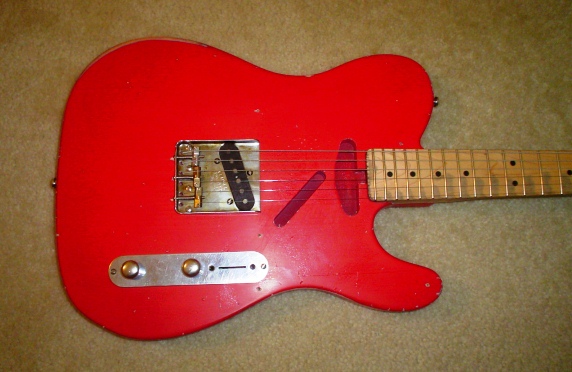
FENDER ESQUIRE ''HOT MOD'' -No Guard-
Fender pine guitar #9! You can tell I really liked the "no guard" look from the Fender '51 ''Nocaster'' -No Guard- project, so here's an Esquire version. Actually, a Billy Gibbons' (ZZ Top) axe I stumbled on in a guitar mag ad inspired me.
I started this project over the summer (2011) and finished it in the fall. Of course, I started with a "blackguard" (channel-routed) Red Dirt Guitar Works pine Tele body, which I primed gray and then sprayed bright red. The body is a two-piece, center-joined slab, and looks great red.
Besides not going with a neck pickup, I needed something else "different" about this Tele. So for the bridge, I went with a left-handed Fender Telecaster setup, which slants the bridge pickup at a reverse angle (you can see the lefty bridge in the Gibbons' ad). This did, however, require some routing under the bridge to accommodate the the new angle. Also, for the three saddles, I took another queue from Billy Gibbons and went with an aluminum/brass combo set with the E/A pair using aluminum and the D/G, B/E pairs coming off the standard brass saddles. Believe it or not, I could tell the difference when I strung this thing up - the way the aluminum saddle resonates gives it a more hollow tone with some added pop. Very interesting.
For the pickup, I wanted to go with a high-output model, and after considering a few options, I settled on DiMarzio's Area Hot T and it's a great humbucking pickup. Hot tone with a lot of power and output with no noise. Makes this Tele sounds like a monster - nothing thin and twangy here. I wired up the humbucker to a Carvin mini 500K volume and tone with a .033 Sprague Orange Drop tone capacitor and a .001 volume cap, along with the standard Switchcraft jack.
For the neck, I went with a maple Mighty Mite V-back and aged it appropriately. I applied a vintage Fender Esquire waterslide and relic'd that, as well. For the hardware, I went with chrome locking GFS tuners, an aluminum Electrosocket jack cup, a chrome Fender neck plate, a chrome control cavity plate, and chrome Carvin knobs - everything aged, of course. And because this axe is to represent a 1950-modded model, I used all slotted screws (except for the saddle intonations screws). No pickguard here, but I did drill screw holes as if there was a pickguard on there for a short period of time. Of course, there were no standard-issued, one-pickup Esquires in 1950 in red, but Fender would have gladly sprayed one red for a known customer, and for an extra charge. So who knows?
Overall, it wasn't too bad to put this one together. Wiring one pickup was easy, but in general, aging a maple neck is a pain. Also, routing the bridge takes a little time to do it right. But this one, like my Fender ''La Cabronita Especial'' Custom, it sounds bigger and badder than a standard Tele. Make it a "hot-mod" Tele. Way cool.
October 2011
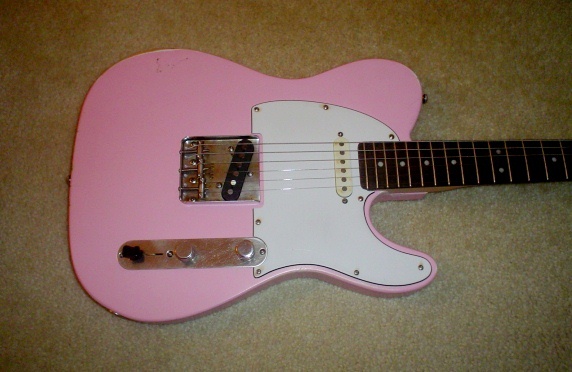
FENDER TELECASTER -Strat Tone-
Fender pine guitar #10! Everyone needs at least one pink guitar - especially if it's a Telecaster.
I had seen pictures of a couple of cool-looking pink Teles and wanted to put a twist on it by putting a Stratocaster pickup in the neck position instead of the standard chrome Telecaster neck pickup, as is commonly done.
I picked up an inexpensive three-piece Red Dirt Guitar Works pine Tele body, with a standard route. I expanded the neck pickup route to fit a Strat single-coil pickup, which is a little wider than a Tele neck pickup. And because of the True-Coil Strat pickup I chose, I had to route the area a little deeper, too. And liked the look of a rosewood fretboard against the pink body and white pickguard, so I went with the standard Mighty Mite 22-fret, rosewood board neck.
Speaking of pickups, I decided on a GFS Alnico Fatbody Overwound Tele bridge pickup, and a GFS True-Coil 6.0K Strat pickup for the neck position (and I aged both). I also added CTS pots (500K volume, 250K tone), a Fender 3-way switch, and a Switchcraft output jack. For capacitors, I went with a .033 Sprague Orange Drop (tone) and a standard .001 ceramic (volume), and I wired everything up.
Hardware-wise, I chose a chrome 1960s Fender ashtray Tele bridge with the grooved steel saddles (for each string), which were used in the late 1960s. For the tuners, I went with a set of chrome GFS locking. Also used were a GFS white pickguard (pre-cut for a Strat neck pickup), an Electrosocket jack cup, a 1960s Fender neck plate, and Schaller straplocks.
I meant for this guitar to represent a modified 1969 Telecaster, although "shell pink" Teles were only offered in the Fender catalogs in 1961 and 1962. Still, I imagine one-off pink Teles could be had for a surcharge, and it wasn't that rare for players to swap out the Tele neck pickup for a fuller/louder Strat pickup. The gold/black Fender Telecaster decal on the headstock combines the 1966-67 "transition" Fender logo and the late 60s/70s-style, "long block" lettering of TELECASTER.
Overall, everything was easy and I always enjoy painting, routing, soldering, and aging hardware. Both GFS sound incredible (amazing value) and the True-Coil neck pickup actually has a mini second coil under the main single-coil to cancel out hum - very cool. Lots of fun & it plays great - and it gets the best of the Tele and Strat worlds!
September 2012
back to the main PINE TELES page










